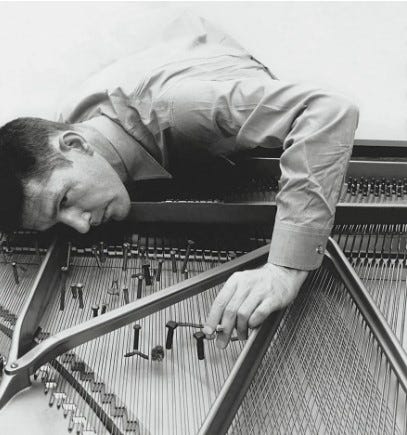Cultural Collapse: From Puccini to John Cage
The Negative Impact of the CIA on Artistic Movements
In the span of a single generation, the landscape of artistic evolution witnessed a catastrophic decline. From Western civilization's high point of Giacomo Puccini’s Turandot (1926) to the postmodern low point of John Cage’s Water Walk (1959), this period highlights extreme contrasts in aesthetic values, arts funding, and outreach.
Giacomo Puccini
John Cage inserting screws, silverware, and other objects into the piano to distort its sound.
The early 20th century, represented by Puccini’s Turandot, epitomized the classical aesthetic of the Enlightenment, characterized by grandeur, emotional depth, and rich innovations in colorful orchestration. Puccini’s work thrived within a framework of transparency and organic popularity, supported by direct and traditional financial funding. In contrast, by the mid-20th century, the emergence of postmodernism, exemplified by Cage’s Water Walk, marked the antithesis of these ideals. Cage’s nihilism, which shat on meaningful music and art, gave us a sewer scum puddle's reflection of humanity. This was made possible through the CIA's covert funding and propaganda.
The evolution and devolution of artistic funding underscore this transition. Puccini’s success was facilitated by direct popular support and through performance fees and copyright (newly developed) royalties, creating a fair environment where the artists could have royalties. In stark contrast, postmodern artists like Cage operated within a complex undercover network. The New York School, which included Cage, benefited from CIA funding channeled through major foundations like Rockefeller, Ford, and Carnegie. It was part of the Cold War cultural strategy, which in practice was to destroy Western civilization in the name of freedom.
CIA's covert funding and cultural propaganda significantly altered the artistic landscape, shifting from transparency and organic popularity to intense cultural manipulation. This change created a favored postmodern class and resulted in neutering genuine artistic movements, diminishing their visibility and consigning many artists to obscurity. This strategic glorification of nihilism created an uneven playing field, driving cultural and artistic values over the edge into an abyss.
The contrast between Puccini’s Turandot and Cage’s Water Walk highlights a profound decline in Western civilization within a single generation.
*****
Giacomo Puccini, Nessun Dorma aria from Turandot (1926).
Classical opera eudaemonia.
John Cage, Water Walk (1960).
Postmodern music.






WWII killed our culture. Yeah, we had a few nice blips, but the rot had truly set in - from the academy to the practitioner to the ways of funding and promoting all the arts.
The war told us that humans could be discarded like chaff. Given that, why invest in humanity to create art for humans?
So the avant garde killed art.
Wow, listening to the two back to back is extremely jarring! I usually enjoy classical music without voice, but I was surprised and inspired by the warmth, richness, and depth of the voice of Puccini. Cage’s performance felt like a stunt or a joke, impersonal. Reminded me of the three stooges somehow.